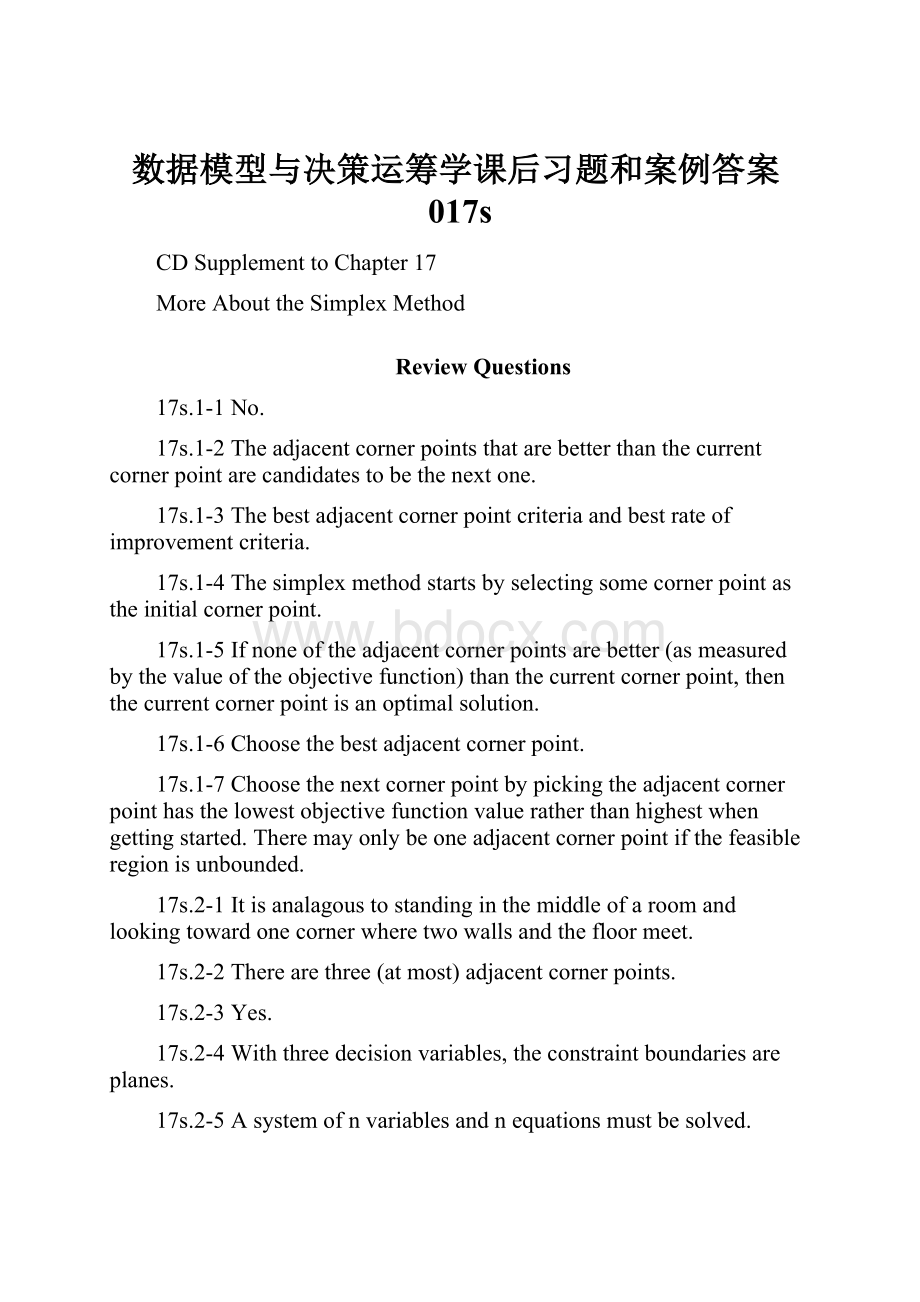数据模型与决策运筹学课后习题和案例答案017s.docx
《数据模型与决策运筹学课后习题和案例答案017s.docx》由会员分享,可在线阅读,更多相关《数据模型与决策运筹学课后习题和案例答案017s.docx(22页珍藏版)》请在冰豆网上搜索。

数据模型与决策运筹学课后习题和案例答案017s
CDSupplementtoChapter17
MoreAbouttheSimplexMethod
ReviewQuestions
17s.1-1No.
17s.1-2Theadjacentcornerpointsthatarebetterthanthecurrentcornerpointarecandidatestobethenextone.
17s.1-3Thebestadjacentcornerpointcriteriaandbestrateofimprovementcriteria.
17s.1-4Thesimplexmethodstartsbyselectingsomecornerpointastheinitialcornerpoint.
17s.1-5Ifnoneoftheadjacentcornerpointsarebetter(asmeasuredbythevalueoftheobjectivefunction)thanthecurrentcornerpoint,thenthecurrentcornerpointisanoptimalsolution.
17s.1-6Choosethebestadjacentcornerpoint.
17s.1-7Choosethenextcornerpointbypickingtheadjacentcornerpointhasthelowestobjectivefunctionvalueratherthanhighestwhengettingstarted.Theremayonlybeoneadjacentcornerpointifthefeasibleregionisunbounded.
17s.2-1Itisanalagoustostandinginthemiddleofaroomandlookingtowardonecornerwheretwowallsandthefloormeet.
17s.2-2Therearethree(atmost)adjacentcornerpoints.
17s.2-3Yes.
17s.2-4Withthreedecisionvariables,theconstraintboundariesareplanes.
17s.2-5Asystemofnvariablesandnequationsmustbesolved.
17s.3-1Thenamederivesfromthefactthattheslackvariablefora≤constraintrepresentstheslack(gap)betweenthetwosidesoftheinequality.
17s.3-2Anonnegativeslackvariableimpliesthattheleft-handsideisnotlargerthantheright-handside.
17s.3-3FortheWyndorproblem,theslackvariablesrepresentunusedproductiontimesinthevariousplants.
17s.3-4Itismuchsimplerforanalgebraicproceduretodealwithequationsthanwithinequalities.
17s.3-5Anonbasicvariablehasavalueofzero.
17s.3-6Abasicfeasiblesolutionissimplyacornerpointthathasbeenaugmentedbyincludingthevaluesoftheslackvariables.
17s.3-7Asurplusvariablegivestheamountbywhichtheleft-handsideofa≥constraintexceedstheright-handside.
17s.4-1
(1)Determinetheenteringbasicvariable;
(2) determinetheleavingbasicvariable;(3) Solveforthenewbasicfeasiblesolution
17s.4-2Theenteringbasicvariableisthecurrentnonbasicvariablethatshouldbecomeabasicvariableforthenextbasicfeasiblesolution.Amongthenonbasicvariableswithanegativecoefficientinequation0,choosetheonewhosecoefficienthasthelargestabsolutevaluetobetheenteringbasicvariable.
17s.4-3Theleavingbasicvariableisthecurrentbasicvariablethatshouldbecomeanonbasicvariableforthenextbasicfeasiblesolution.Foreachequationthathasastrictlypositivecoefficient(neitherzeronornegative)fortheenteringbasicvariable,taketheratiooftheright-handsidetothiscoefficient.Identifytheequationthathastheminimumratio,andselectthebasicvariableinthisequationtobetheleavingbasicvariable.
17s.4-4Theinitializationstepsetsuptostarttheiterationsandfindstheinitialbasicfeasiblesolution.
17s.4-5Examinethecurrentequation0.Ifnoneofthenonbasicvariableshaveanegativecoefficient,thenthecurrentbasicfeasiblesolutionisoptimal.
17s.4-6
(1)Equation0doesnotcontainanybasicvariables;
(2)eachoftheotherequationscontainsexactlyonebasicvariable;(3)anequation’sonebasicvariablehasacoefficientof1;(4)anequation’sonebasicvariabledoesnotappearinnanyotherequation.
17s.4-7Thetabularformperformsexactlythesamestepsasthealgebraicform,butrecordstheinformationmorecompactly.
Problems
17s.1
GettingStarted:
Select(0,0)astheinitialcornerpoint.
CheckingforOptimality:
Both(0,3)and(3,0)havebetterobjectivefunctionvalues(Z=6and9,respectively),so(0,0)isnotoptimal.
MovingOn:
(3,0)isthebestadjacentcornerpoint,somoveto(3,0).
CheckingforOptimality:
(2,2)hasabetterobjectivefunctionvalue(Z=10),so(3,0)isnotoptimal.
MovingOn:
Movefrom(3,0)to(2,2).
CheckingforOptimality:
(0,3)haslowerobjectivefunctionvalues(Z=6),so(2,2)isoptimal.
17s.2
GettingStarted:
Select(0,0)astheinitialcornerpoint.
CheckingforOptimality:
Both(0,2.667)and(4,0)havebetterobjectivefunctionvalues(Z=5.333and4,respectively),so(0,0)isnotoptimal.
MovingOn:
(0,2.667)isthebestadjacentcornerpoint,somoveto(0,2.667).
CheckingforOptimality:
(2,2)hasabetterobjectivefunctionvalue(Z=6),so(0,2.667)isnotoptimal.
MovingOn:
Movefrom(0,2.667)to(2,2).
CheckingforOptimality:
(4,0)hasalowerobjectivefunctionvalues(Z=4),so(2,2)isoptimal.
17s.3
GettingStarted:
Select(0,0)astheinitialcornerpoint.
CheckingforOptimality:
Both(0,5)and(4,0)havebetterobjectivefunctionvalues(Z=10and12,respectively),so(0,0)isnotoptimal.
MovingOn:
(4,0)isthebestadjacentcornerpoint,somoveto(4,0).
CheckingforOptimality:
(4,2)hasabetterobjectivefunctionvalue(Z=16),so(4,0)isnotoptimal.
MovingOn:
Movefrom(4,0)to(4,2).
CheckingforOptimality:
(3,4)hasabetterobjectivefunctionvalue(Z=17),so(4,2)isnotoptimal.
MovingOn:
Movefrom(4,2)to(3,4).
CheckingforOptimality:
(0,5)hasalowerobjectivefunctionvalues(Z=10),so(3,4)isoptimal.
17s.4a)
GettingStarted:
Select(0,0)astheinitialcornerpoint.
CheckingforOptimality:
Both(2,0)and(0,5)havebetterobjectivefunctionvalues(Z=4and5,respectively),so(0,0)isnotoptimal.
MovingOn:
(0,5)isthebestadjacentcornerpoint,somoveto(0,5).
CheckingforOptimality:
(2,5)hasabetterobjectivefunctionvalue(Z=9),so(0,5)isnotoptimal.
MovingOn:
Movefrom(0,5)to(2,5).
CheckingforOptimality:
(2,0)hasalowerobjectivefunctionvalues(Z=4),so(2,5)isoptimal.
b)GettingStarted:
Select(0,0)astheinitialcornerpoint.
CheckingforOptimality:
Movingtowardeither(2,0)or(0,5)improvestheobjectivefunctionvalue,so(0,0)isnotoptimal.
MovingOn:
Movingtoward(2,0)improvestheobjectivefunctionfasterthanmovingtoward(0,5)(arateof2vs.arateof1),somoveto(2,0).
CheckingforOptimality:
Movingtoward(2,5)improvestheobjectivefunctionvalue,so(2,0)isnotoptimal.
MovingOn:
Movefrom(2,0)to(2,5).
CheckingforOptimality:
Movingtoward(0,5)lowerstheobjectivefunctionvalues,so(2,5)isoptimal.
17s.5a)
b)Theeightcornerpointsare(x1,x2,x3)=(0,0,0),(0,0,1),(0,1,0),(0,1,1),(1,0,0),(1,0,1),(1,1,0),and(1,1,1).
c)ObjectiveFunction:
Profit=x1+2x2+3x3
OptimalSolution:
(x1,x2,x3)=(1,1,1)andProfit=6.
CornerPoint(x1,x2,x3)
Profit=x1+2x2+3x3
(0,0,0)
0
(0,0,1)
3
(0,1,0)
2
(0,1,1)
5
(1,0,0)
1
(1,0,1)
4
(1,1,0)
3
(1,1,1)
6
d)Thesimplexmethodwouldstartat(0,0,0),movetothebestadjacentcornerpointat(0,0,1),thento(0,1,1),andfinallytotheoptimalsolutionat(1,1,1).
17s.6a)
b)Thetencornerpointsare(x1,x2,x3)=(0,0,0),(2,0,0),(2,2,0),(1,3,0),(0,3,0),(0,0,2),(2,0,2),(2,2,2),(1,3,2),(0,3,2)
c)ObjectiveFunction:
Profit=2x1+x2–x3
OptimalSolution:
(x1,x2,x3)=(2,2,0)andProfit=6.
CornerPoint(x1,x2,x3)
Profit=2x1+x2–x3
(0,0,0)
0
(2,0,0)
4
(2,2,0)
6
(1,3,0)
5
(0,3,0)
3
(0,0,2)
–2
(2,0,2)
2
(2,2,2)
4
(1,3,2)
3
(0,3,2)
1
d)Thesimplexmethodwouldstartat(0,0,0),movetothebestadjacentcornerpointat(2,0,0),andthentotheoptimalsolutionat(2,2,0).
17s.7a)s1=10–x2
s2=20–2x1–x2
b)s1≥ 0ands2≥0.
c)x2+s1=10
2x1+x2+s2=20
d)Valuesoftheslackvariablesat(x1,x2)=(10,0)ares1=10ands2=0.
Theequationsfortheconstraintboundarylinesonwhich(10,0)liesare
x2=0
2x1+x2=20
Thecorrespondingbasicfeasiblesolutionis(x1,x2,s1,s2)=(10,0,10,0).
Thebasicvariablesarex1ands1;thenonbasicvariablesarex2ands2.
17s.8a)25x1+40x2+50x3≤ 500.
b)s≥0.
c)s=0.
17s.9a)ObjectiveFunction:
Profit=2x1+x2
OptimalSolution:
(x1,x2)=(4,3)andProfit=11
CornerPoint(x1,x2)
Profit=2x1+x2
(0,0)
0
(5,0)
10
(4,3)
11
(0,5)
5
b)Thegraphicalsimplexmethodwouldstartat(0,0),movetothebestadjacentcornerpointat(5,0),andfinallymovetotheoptimalsolutionat(4,3).
c)3x1+2x2+s1=15
x1+2x2+s2=10
d)
BasicFeasibleSolution(x1,x2,s1,s2)
BasicVariables
NonbasicVariables
(0,0,15,10)
s1,s2
x1,x2
(5,0,0,5)
x1,s2
x2,s1
(4,3,0,0)
x1,x2
s1,s2
(0,5,5,0)
x2,s1
x1,s2
e)Thegraphicalsimplexmethodwouldstartat(0,0,15,10),movetothebestadjacentcornerpointat(5,0,0,5),andfinallymovetotheoptimalsolutionat(4,3,0,0).
17s.10a)s1=2x1+3x2–21.
s2=5x1+3x2–30.
b)s1≥ 0ands2≥0.
c)2x1+3x2–s1=21.
5x1+3x2–s2=30.
d)Valuesofthesurplusvariablesat(x1,x2)=(3,5)ares1=0ands2=0.
Theequationsfortheconstraintboundarylinesonwhich(3,5)liesare
2x1+3x2=21
5x1+3x2=30
Thecorrespondingbasicfeasiblesolutionis(x1,x2,s1,s2)=(3,5,0,0).
Thebasicvariablesarex1andx2;thenonbasicvariablesares1ands2.
17s.11a)20x1+10x2≥100.
b)s≥0.
c)s=0.
17s.12a)
GettingStarted:
Select(16,0)astheinitialcornerpoint.(Cost=32.)
CheckingforOptimality:
Both(15,0)and(0,24)havebetterobjectivefunctionvalues(Cost=30and24,respectively),so(16,0)isnotoptimal.
MovingOn:
(0,24)isthebestadjacentcornerpoint,somoveto(0,24).(Cost=24.)
CheckingforOptimality:
(0,20)hasabetterobjectivefunctionvalue(Cost=20),so(0, 24)isnotoptimal.